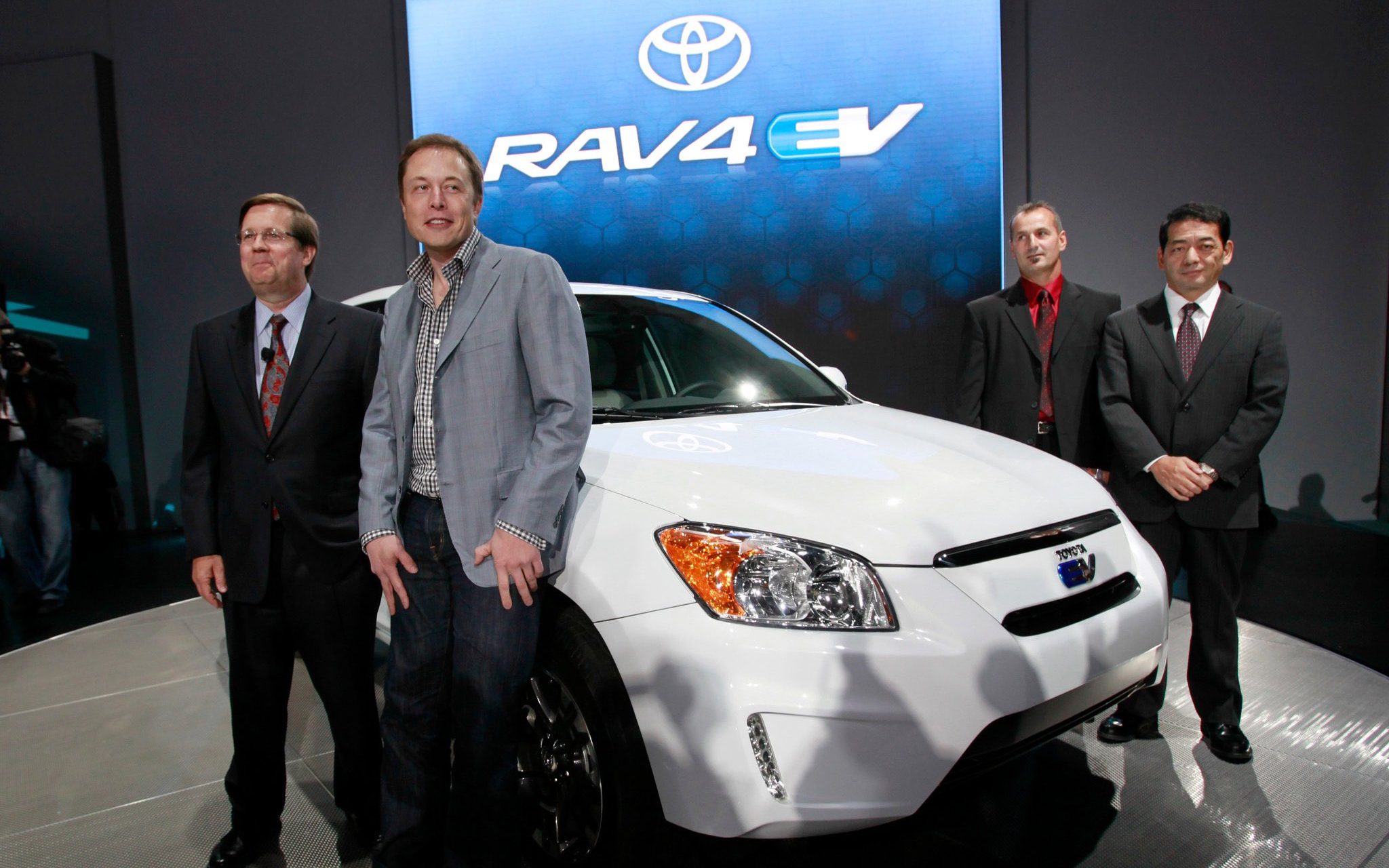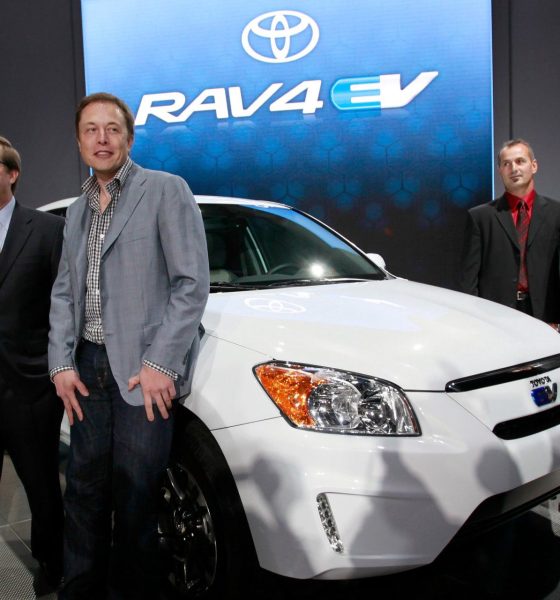

News
Tesla and Toyota to revisit old partnership for new EV development: report
A recent report from an esteemed South Korean publication has suggested that Tesla and Toyota are poised to revisit an old partnership to develop an all-new electric vehicle. The partnership has reportedly been under review since last year.
Citing an official from the Japanese automobile industry, the Chosun Ilbo, one of South Korea’s largest newspapers, stated that the upcoming partnership between Tesla and Toyota would likely result in the development of a small electric SUV. Toyota is reportedly providing the vehicle platform in the partnership, while Tesla will supply some of the EV’s electronic control platform and software.
By adopting such a strategy, the upcoming all-electric vehicle would practically have the best of both companies, as Toyota is experienced in the fundamentals of carmaking and Tesla holds a wide lead in the industry when it comes to software. With Tesla’s electronics and software, the upcoming electric vehicle would likely be ready for over-the-air update capabilities, something that Toyota has not achieved on its own so far.
A small electric SUV jointly developed by Tesla and Toyota would be a formidable competitor in the affordable electric crossover segment. Today, the segment is populated by simple but adequate vehicles like the MG ZS EV, Hyundai Kona Electric, and the Kia Niro EV. An affordable electric SUV with a Toyota platform and Tesla tech would likely be a compelling option for budget-conscious electric vehicle buyers.
A spokesperson from Toyota has neither confirmed nor denied the recent report from the South Korean publication. In a statement, the Toyota spokesperson simply noted that “We would like to refrain from commenting on speculations.”
Toyota spokesman has this to say on South Korean news report about Toyota and Tesla possibly working together. “We would like to refrain from commenting on speculations.” https://t.co/dq1L0zPmEM
— Faiz Siddiqui (@faizsays) March 30, 2021
While the Chosun Ilbo report may seem strange considering Tesla’s ongoing efforts to release an affordable $25,000 car, such a partnership may still work in the Silicon Valley-based company’s favor. Tesla’s $25,000 EV is expected to be a compact car that’s designed for China (and perhaps Europe), after all, which gives the Tesla-Toyota crossover SUV ample space to compete in the low-cost crossover EV market.
Tesla and Toyota actually have some history making vehicles together. Back in the early days of Tesla, the company partnered with Toyota to help build one of the Japanese carmaker’s compliance cars for California, the RAV4 EV. The vehicle featured a range of about 100 miles from its 50 kWh (41.8 kWh usable) battery pack, which came from Tesla. The Elon Musk-led company also developed its powertrain and software.
The RAV4 EV was not sold widely due to its compliance car status, but the vehicle was known to have been loved by its owners, thanks in no small part to its zippy acceleration that enabled a 0-60 mph time of 7 seconds in Sport Mode, its stellar software that included Elon Musk-esque functions like a built-in “smugometer” (a display that tells drivers the amount of CO2 it is not emitting), and its ample range—things that would eventually be the defining characteristics of Tesla’s electric vehicles today.
Don’t hesitate to contact us for news tips. Just send a message to tips@teslarati.com to give us a heads up.

News
Tesla FSD fleet is nearing 7 billion total miles, including 2.5 billion city miles
As can be seen on Tesla’s official FSD webpage, vehicles equipped with the system have now navigated over 6.99 billion miles.

Tesla’s Full Self-Driving (Supervised) fleet is closing in on almost 7 billion total miles driven, as per data posted by the company on its official FSD webpage.
These figures hint at the massive scale of data fueling Tesla’s rapid FSD improvements, which have been quite notable as of late.
FSD mileage milestones
As can be seen on Tesla’s official FSD webpage, vehicles equipped with the system have now navigated over 6.99 billion miles. Tesla owner and avid FSD tester Whole Mars Catalog also shared a screenshot indicating that from the nearly 7 billion miles traveled by the FSD fleet, more than 2.5 billion miles were driven inside cities.
City miles are particularly valuable for complex urban scenarios like unprotected turns, pedestrian interactions, and traffic lights. This is also the difference-maker for FSD, as only complex solutions, such as Waymo’s self-driving taxis, operate similarly on inner-city streets. And even then, incidents such as the San Francisco blackouts have proven challenging for sensor-rich vehicles like Waymos.
Tesla’s data edge
Tesla has a number of advantages in the autonomous vehicle sector, one of which is the size of its fleet and the number of vehicles training FSD on real-world roads. Tesla’s nearly 7 billion FSD miles then allow the company to roll out updates that make its vehicles behave like they are being driven by experienced drivers, even if they are operating on their own.
So notable are Tesla’s improvements to FSD that NVIDIA Director of Robotics Jim Fan, after experiencing FSD v14, noted that the system is the first AI that passes what he described as a “Physical Turing Test.”
“Despite knowing exactly how robot learning works, I still find it magical watching the steering wheel turn by itself. First it feels surreal, next it becomes routine. Then, like the smartphone, taking it away actively hurts. This is how humanity gets rewired and glued to god-like technologies,” Fan wrote in a post on X.
News
Tesla starts showing how FSD will change lives in Europe
Local officials tested the system on narrow country roads and were impressed by FSD’s smooth, human-like driving, with some calling the service a game-changer for everyday life in areas that are far from urban centers.

Tesla has launched Europe’s first public shuttle service using Full Self-Driving (Supervised) in the rural Eifelkreis Bitburg-Prüm region of Germany, demonstrating how the technology can restore independence and mobility for people who struggle with limited transport options.
Local officials tested the system on narrow country roads and were impressed by FSD’s smooth, human-like driving, with some calling the service a game-changer for everyday life in areas that are far from urban centers.
Officials see real impact on rural residents
Arzfeld Mayor Johannes Kuhl and District Administrator Andreas Kruppert personally tested the Tesla shuttle service. This allowed them to see just how well FSD navigated winding lanes and rural roads confidently. Kruppert said, “Autonomous driving sounds like science fiction to many, but we simply see here that it works totally well in rural regions too.” Kuhl, for his part, also noted that FSD “feels like a very experienced driver.”
The pilot complements the area’s “Citizen Bus” program, which provides on-demand rides for elderly residents who can no longer drive themselves. Tesla Europe shared a video of a demonstration of the service, highlighting how FSD gives people their freedom back, even in places where public transport is not as prevalent.
What the Ministry for Economic Affairs and Transport says
Rhineland-Palatinate’s Minister Daniela Schmitt supported the project, praising the collaboration that made this “first of its kind in Europe” possible. As per the ministry, the rural rollout for the service shows FSD’s potential beyond major cities, and it delivers tangible benefits like grocery runs, doctor visits, and social connections for isolated residents.
“Reliable and flexible mobility is especially vital in rural areas. With the launch of a shuttle service using self-driving vehicles (FSD supervised) by Tesla in the Eifelkreis Bitburg-Prüm, an innovative pilot project is now getting underway that complements local community bus services. It is the first project of its kind in Europe.
“The result is a real gain for rural mobility: greater accessibility, more flexibility and tangible benefits for everyday life. A strong signal for innovation, cooperation and future-oriented mobility beyond urban centers,” the ministry wrote in a LinkedIn post.
News
Tesla China quietly posts Robotaxi-related job listing
Tesla China is currently seeking a Low Voltage Electrical Engineer to work on circuit board design for the company’s autonomous vehicles.

Tesla has posted a new job listing in Shanghai explicitly tied to its Robotaxi program, fueling speculation that the company is preparing to launch its dedicated autonomous ride-hailing service in China.
As noted in the listing, Tesla China is currently seeking a Low Voltage Electrical Engineer to work on circuit board design for the company’s autonomous vehicles.
Robotaxi-specific role
The listing, which was shared on social media platform X by industry watcher @tslaming, suggested that Tesla China is looking to fill the role urgently. The job listing itself specifically mentions that the person hired for the role will be working on the Low Voltage Hardware team, which would design the circuit boards that would serve as the nervous system of the Robotaxi.
Key tasks for the role, as indicated in the job listing, include collaboration with PCB layout, firmware, mechanical, program management, and validation teams, among other responsibilities. The role is based in Shanghai.
China Robotaxi launch
China represents a massive potential market for robotaxis, with its dense urban centers and supportive policies in select cities. Tesla has limited permission to roll out FSD in the country, though despite this, its vehicles have been hailed as among the best in the market when it comes to autonomous features. So far, at least, it appears that China supports Tesla’s FSD and Robotaxi rollout.
This was hinted at in November, when Tesla brought the Cybercab to the 8th China International Import Expo (CIIE) in Shanghai, marking the first time that the autonomous two-seater was brought to the Asia-Pacific region. The vehicle, despite not having a release date in China, received a significant amount of interest among the event’s attendees.








